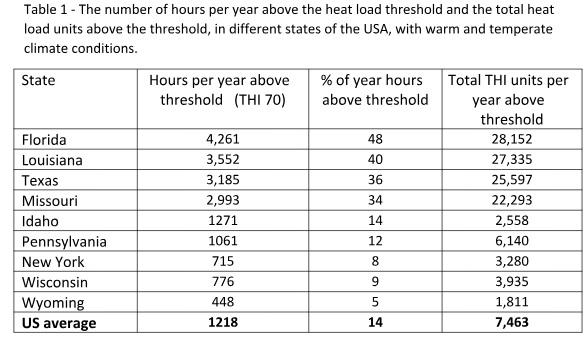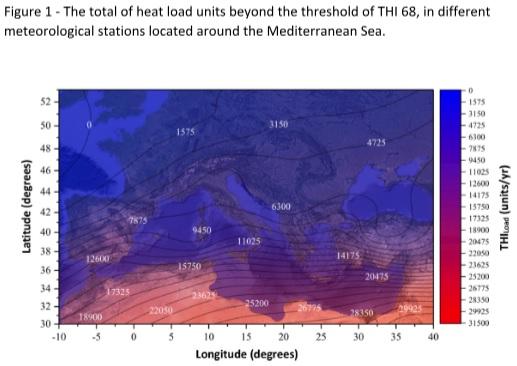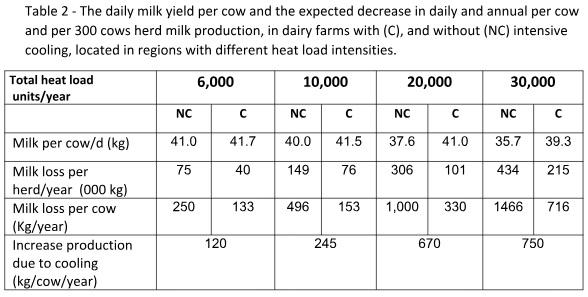Models examining the feasibility of investing in cooling systems in dairy farms located in regions with different heat load intensities
Published: July 29, 2023
By: Israel Flamenbaum / Cow Cooling Solutions Ltd, Israel.
An article dealing with this topic was recently published in the prestigious journal of the dairy industry, Journal of Dairy Science (Espinoza-Sandoval et. al., JDS 106: 2023). The article examines, using a statistical model, the feasibility of investing in cooling the cows in the summer in various countries around the Mediterranean Sea (Europe, North Africa and the Middle East), where there are different “climate zones” regarding dairy farming. The model presented in this article is largely based on the format in which a previous study was carried out, 20 years ago, dealing with the same topic, and was published in the same newspaper (St. Pierre et. al. JDS 86: E52, 2003). This article also examined the heat stress and cow cooling issue, for the different states of the USA, having also great variation in regards to climatic conditions and their effect on the dairy industry.
Let's start with the article published 20 years ago. The researchers examined the intensity of the heat load in the different states, by counting the number of hours per year where the heat load index (THI) was above the value of 70, considered as the threshold value, beyond which the cows suffer heat stress. They calculated also the annual sum of heat load units above the threshold value, defining it as “THI Load”. The study covered the period of last 50 years, in 250 meteorological stations located in 50 US states. To illustrate the climatic variation, I chose to present in the following table, the data on number of hours in which the heat load was above the threshold value, and the total units above it, in several states in the US, warm and temperate states.

From the presented in Table 1, it can be seen a great variation between the different regions of the USA in regards to the intensity and scope of the heat load to which the cows are exposed along the year. In the southern states, such as Florida and Texas, the cows are In conditions of heat load between one third and half of the year time, while in the northern states, this happens in less than 10% of year time.
Using the formats developed for this purpose, the researchers found that between the warmest and coolest regions, the reduction in per cow annual Dry Matter consumption is expected to range between 1030 and 30 kg, per cow milk production between 2000 and 70 kg, and additional “open days” between 57 and 4 days, respectively.
As to the economic aspect - the researchers found that the total economic loss caused by heat load conditions to USA dairy sector reaches 1.500 million dollars per year. In warm states such as Florida and Texas, where annual milk production losses per cow are around 2,000, the annual income per cow decreases by 350 to 400 dollars, while in the cooler states, the annual loss per cow is not more than 30 dollars. On a national basis, average per cow annual loss is 170 dollars. By implementing optimal cooling means in the summer months, adapted to the climatic conditions of each state, the loss of income for the entire industry may be reduced from $1,500 million to $890 million (reduction by 40%), while the annual loss for the average cow in the US is reduced from $170 to $100. The data presented here is based on studies with the contribution of cooling methods in use, more than 20 years ago. Today, with the accumulated knowledge on cow cooling, obtained in recent years, its proper application is expected to reduce to a greater extent, the drop caused by heat stress to the cows.
Now, let return to the recently published article, which adopted the research methods carried out by St Pierre et al. Referring to recent studies, and due to the increase in the cow’s milk production in the last 20 years (which means more heat to dissipate and higher sensitivity to heat), the researchers decided to lower the threshold value to THI 68. The researchers selected 21 meteorological stations, located in different parts of the Mediterranean Sea, in which the number of heat load units above threshold value was calculated. The data is presented in Figure 1.

From the presented in Figure 1, and similarly to the data presented in St. Pierre's article, one can learn about the large variation in the intensity of the heat load in the different regions. The warmest place to my surprise was the city where I live, Tel Aviv, with about 31,000 units of heat load above the threshold of 68, very much different from stations located in Northern European countries, where the number of units above the threshold ranges from only 1,500 to 3,000. In a step later, the researchers calculated, the expected decrease in the daily and annual cow’s milk yield, while adopting recent data concerning the contribution of best cooling measures. The improvement obtained in regions with different heat load intensities (defined on number of annual heat units above the threshold value of 68 in each region) can be seen in Table 2.

From what is shown in Table 2, it can be clearly seen that the greater the intensity of annual heat load, the greater the losses in milk production, and what is no less important, the greater the benefit from implementing cooling measures is. In the warmest regions (among which also Israel is included), the heat load in the summer reduces the annual production per cow by nearly 1,500 kg, when optimal operation of cooling means can reduce these losses to half. It should be noted that there are dairy farms in Israel today, that are already successful, through the Intensive operation of their cooling systems, combining sequences of wetting and forced ventilation for 6 to 8 cumulative hours a day, to reduce the annual production losses by nearly 90%. In such cases, the economic benefit from cooling the cows will be much greater than the one presented in the actual model.
When coming to the economic losses from being the cows subjected to heat load conditions on the one hand, and on the other hand, the economic benefits obtained from optimal operation of cooling means, the researchers analyzed this issue in different scenarios and for different regions in countries around the Mediterranean Sea. In their model, based on data from about four years ago, the researchers took into account an investment in cooling equipment at a cost of 100 or 200 euros per cow, and milk prices ranging from 0.28 to 0.36 euros per kg of milk. Analyzing the model for different regions shows that cooling the cows has the potential to increase income over feed cost (IOFC), by 0.15 and 0.70 Euro per cow/day, in the moderate and warmest studied regions, respectively. Under extreme climatic conditions, such as those existing in Israel, with 30,000 heat load units per year, where cooling has the potential to reduce the loss caused by the heat load in the summer to half, and in the scenario where cooling expenses and milk price are the highest, the increase in annual income per cow can reach 225 Euro.
I must clarify that there are some other factors, which I consider important. The two models presented in this article took into account, on the one hand, the negative effect of heat stress on feed consumption, milk yield, “open days” and culling rate. At the same time, they took into account the improvements expected from optimal use of cooling means in the summer (based on the results of research studies on the subject). However, both models do not take into account some other factors that are negatively influenced by heat stress, such as the negative effect of heat load on milk composition (mainly fat and protein content), milk quality (somatic cells count, SCC), and the decrease feed efficiency (rate of conversion of feed into milk). I assume that Including these factors in the model will more correctly and comprehensively present the real losses caused by heat load (and thus bring to the attention of world’s milk producers the extent of their true losses). On the other hand, presenting the true and real benefits resulting from optimal implementation of cooling means will encourage the farmers to make the required investments and necessary effort for its proper implementation.
Related topics:
Authors:
Recommend
Comment
Share

Would you like to discuss another topic? Create a new post to engage with experts in the community.





.jpg&w=3840&q=75)